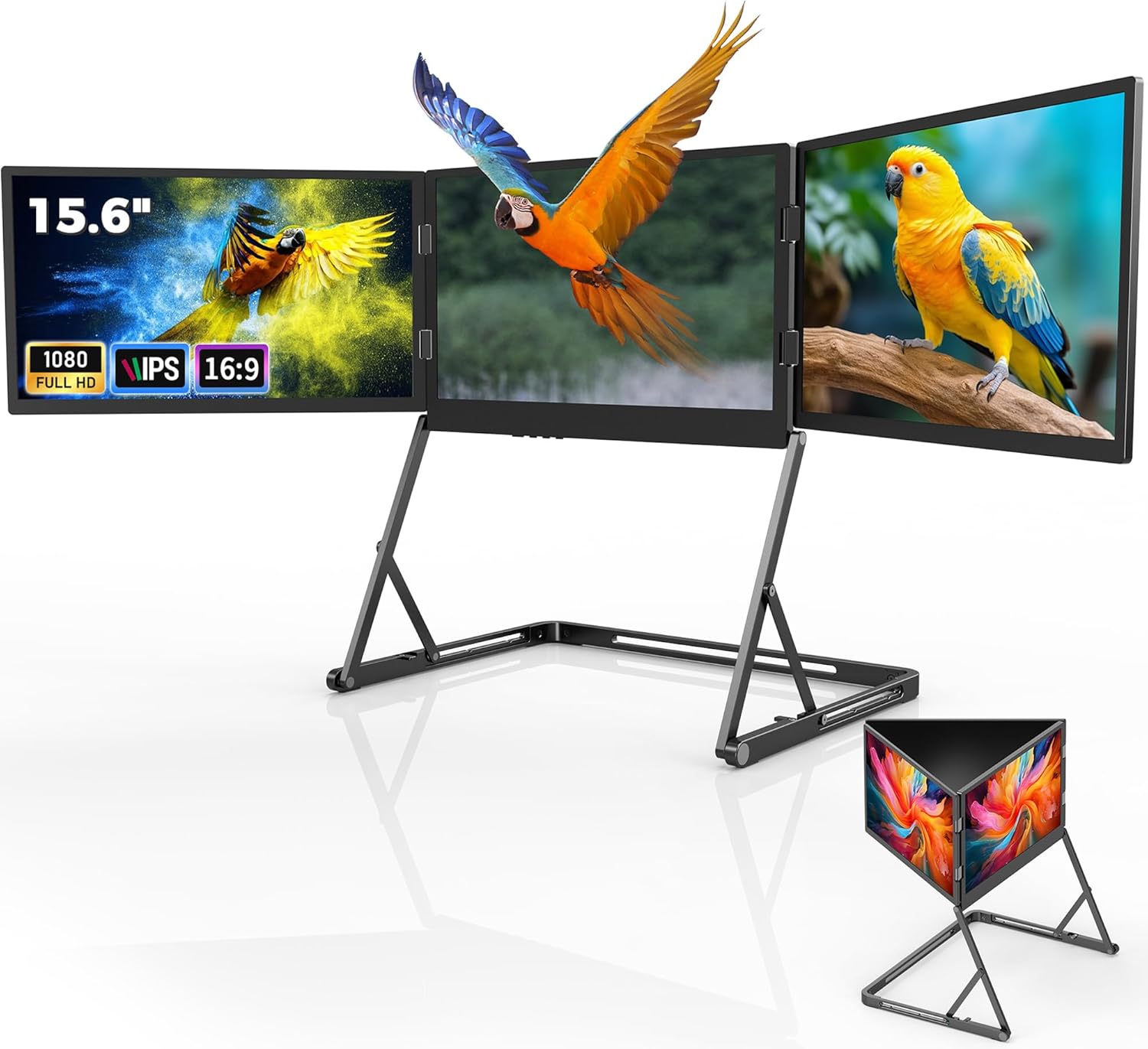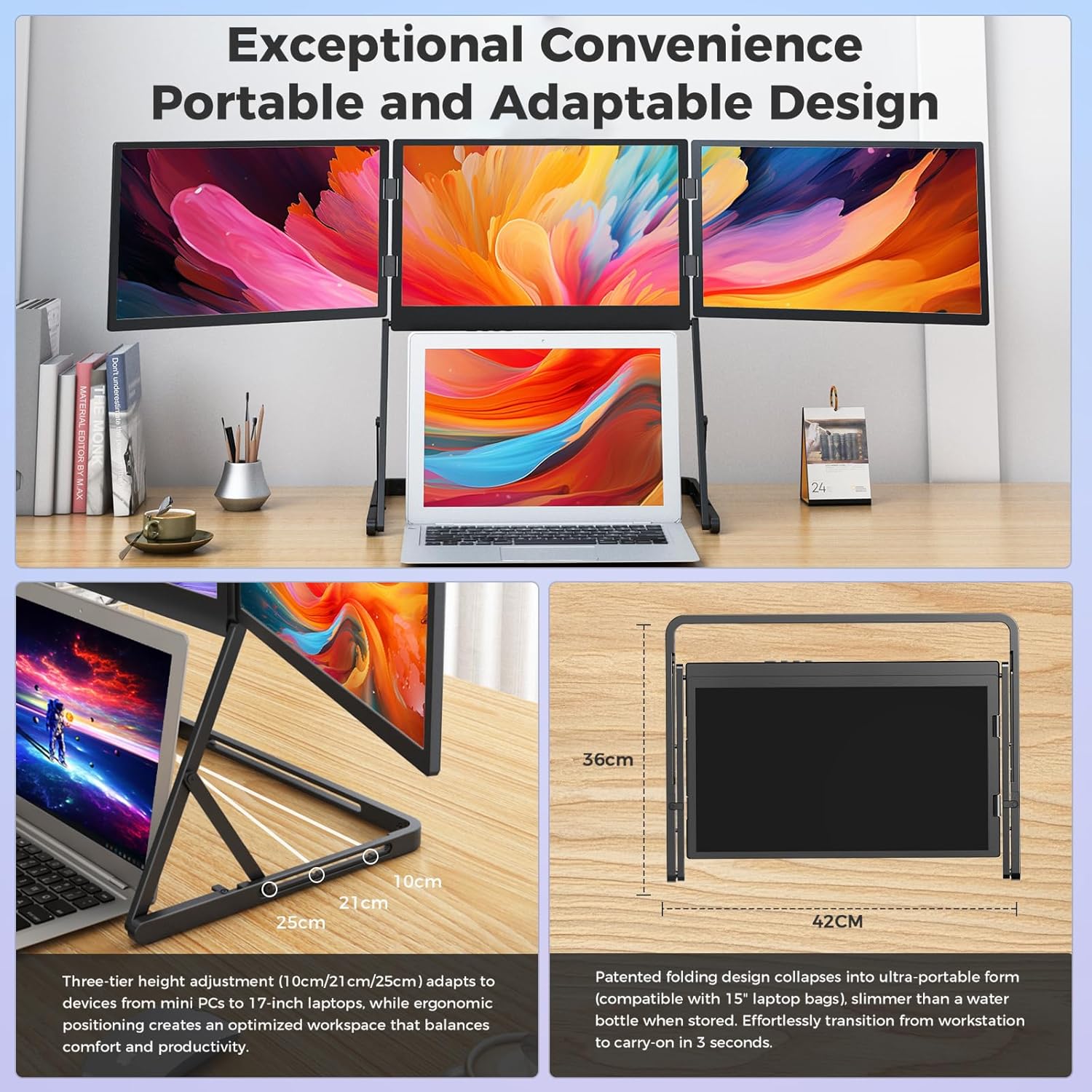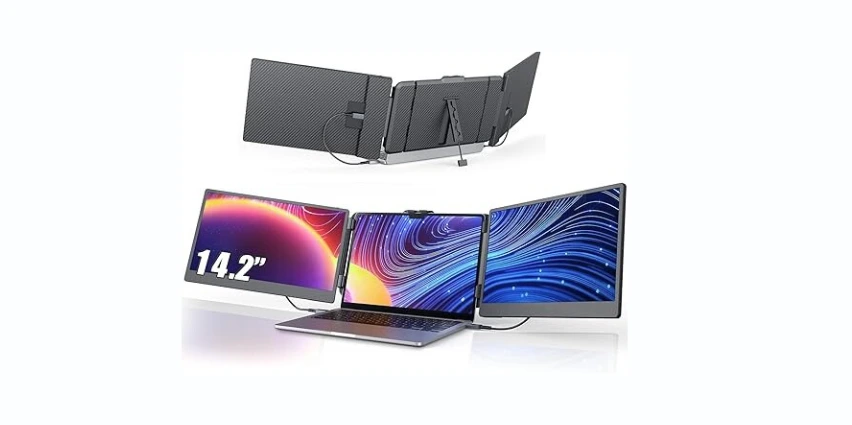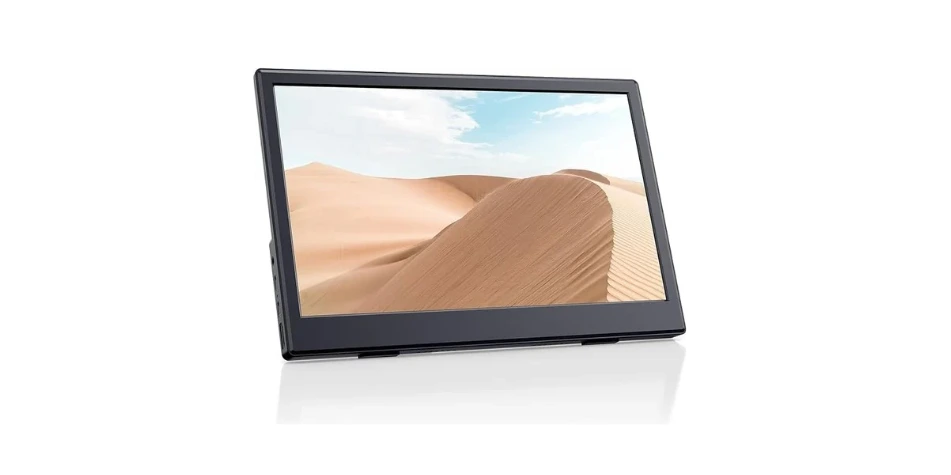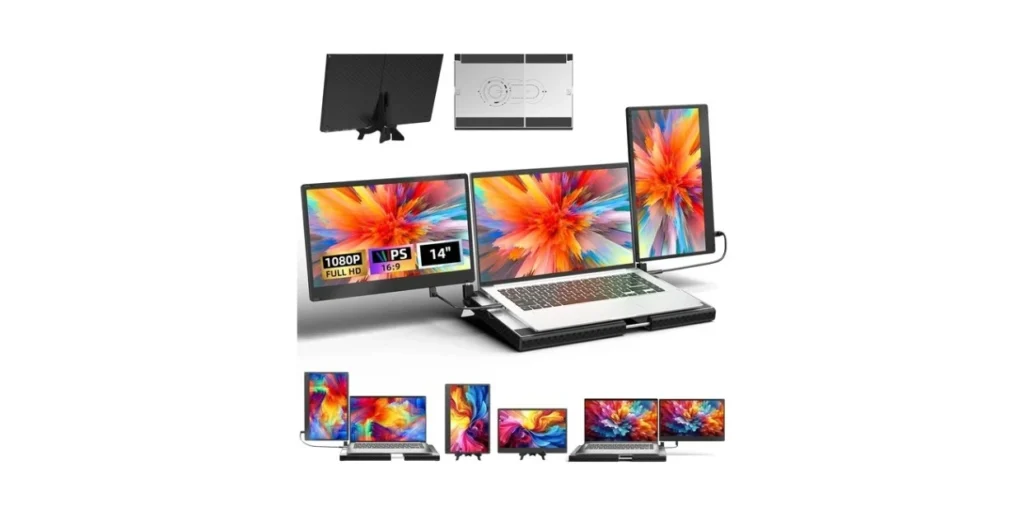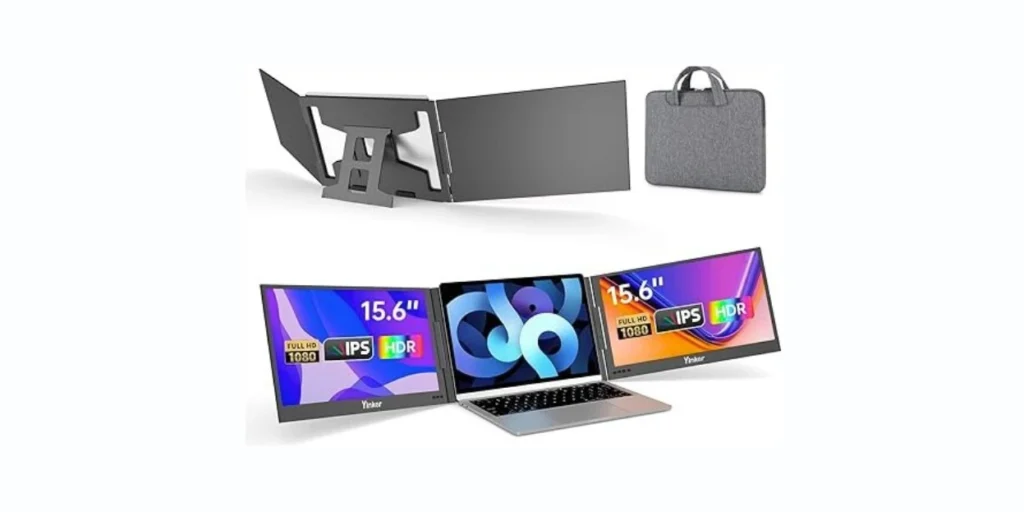Have we ever tried balancing a spreadsheet, a video call, and a deadline on one lonely laptop screen and thought, there has to be a saner way to live?
What This Triple-Monitor Extender Promises Us
We’re looking at the “Laptop Screen Extender, 15.6″ FHD 1080P IPS Portable Foldable Triple Monitor, Laptop Monitor Extender, HDMI/USB-C Plug n Play for Windows, Mac, Android, with a Felt Protective Sleeve.” It’s a mouthful, the sort of name that sounds like someone filled a shopping cart with every spec they loved and forgot to put spaces between them. Still, behind the maximalist phrasing sits a clear promise: three 15.6-inch Full HD screens, neatly folded into a portable unit, meant to turn a laptop into a command center wherever we plant ourselves.
We all know what it’s like to shuffle window after window on a 13- or 15-inch display. With this setup, we keep our video meeting on one screen, our actual work on the second, and an overambitious to-do list on the third, all without juggling tabs like we’re auditioning for a circus we didn’t ask to join.
The Big Picture: Three FHD Panels, One Portable Package
Three IPS panels at 1920×1080 create a familiar, easy-to-drive resolution across a total of three screens. The 72% NTSC color gamut suggests we’re in the ballpark of full sRGB, which is more than fine for productivity, design mockups, and casual color work. HDR support is listed, which in practice usually means we get a touch more pop in contrast and highlights on compatible content, though we keep expectations modest given the power and brightness limits of portable displays.
The bezels are slim enough to let our eyes sweep across without hard stops, and each panel’s controls for brightness and contrast sit within a comfortable reach. Angle and rotation adjustments are built in, making it easy to bend the ensemble to our preferences—wider when we want a cinematic spread, tighter when desk space is scarce, and rotated when a vertical document demands its own newspaper column.
Unboxing, Without the Cardboard Poetry
We open the package to a neat roll call: the tri-panel monitor unit, a 65W PD power adapter, a USB drive preloaded with drivers, a USB-C power cable, a separate USB-C data cable, an HDMI to mini HDMI cable, a user manual, and a felt sleeve. There’s no scavenger hunt, which we appreciate. Everything we need to power, connect, and carry it is accounted for.
The felt sleeve is an unexpectedly thoughtful touch. It’s soft, handsome, and practical—like that cardigan we keep for meetings that don’t really need a cardigan. The sleeve stands up vertically in a bag, which makes it feel more like a slim notebook than a glowing winged contraption.
Key Specs and What They Mean for Us
Let’s keep our heads clear with a quick breakdown. We love a good table when it tells us what we actually need to know.
| Area | What We Get | Why It Matters |
|---|---|---|
| Panel count | 3 × 15.6″ IPS, FHD 1080p | A familiar, crisp resolution across three screens; easy on the GPU and battery. |
| Color | 72% NTSC, HDR support | Approximate sRGB-level coverage; suitable for office, content, and light creative work. |
| Bezels & Controls | Slim bezels, onboard brightness/contrast controls | Makes multi-screen flow natural; easy per-screen adjustment. |
| Adjustability | Angles and rotation per panel | Tailor each screen; flip for vertical docs or share mode. |
| Ports & Input Modes | Single-cable USB-C (with DP Alt Mode), USB-C + HDMI hybrid, or triple HDMI | Flexible connection paths depending on our laptop’s capabilities. |
| OS Compatibility | Windows, macOS, Linux, Android | Broad support; drivers included on a USB drive. |
| Power | 65W PD adapter included | Stable power for long sessions; reduces laptop battery drain. |
| Portability | Foldable tri-panel unit, felt sleeve | Compact travel setup; minimal desk space needed. |
| Included Accessories | USB-C power + data cables, HDMI–mini HDMI cable, USB drive, sleeve | No extra shopping for cables on day one. |
| Support | Dedicated customer support | We’re not left guessing if something needs troubleshooting. |
Setup: Three Ways to Get to Triple
Getting three screens to play nicely with a motley cast of laptops and operating systems once required ritual chanting and a hardware sacrificial lamb. Here, it’s refreshingly straightforward—though we still need to know what our laptop supports.
Method 1: Single-Cable USB-C (DP Alt Mode and Bandwidth Will Vary)
If our laptop has a full-function USB-C port with DisplayPort Alt Mode—and enough bandwidth and driver support—it can drive all three screens with a single cable. This is the cleanest setup for newer Windows laptops with robust USB-C implementation and MST (Multi-Stream Transport) support.
On macOS, the waters are more nuanced. Apple Silicon base chips (M1, M2, M3 non-Pro/Max) natively support only one external display, so multiple extended displays typically require a driver-based workaround. That’s where the included driver solution steps in, treating extra screens via a virtual GPU over USB. It works well for office tasks and most day-to-day work but can add a touch of latency compared to native GPU connections. For MacBook Pro models with more robust multi-display support, we still might rely on the included driver for the clean single-cable experience.
Method 2: USB-C + HDMI Hybrid
This hybrid approach splits the workload. One screen takes video through HDMI, while the others ride USB-C. This tends to work well with a wide range of machines, including older laptops, and helps sidestep bandwidth constraints. It’s a practical middle ground when we want three screens but the laptop’s USB-C won’t carry all of them at once.
Method 3: Three HDMI Inputs
If our laptop or dock can spare the ports, we can feed each screen via HDMI. It’s not the tidiest solution, but it’s the most universally compatible because HDMI is the cockroach of ports—ubiquitous, resilient, and slightly annoying when we’re trying to keep a desk neat. For stationary setups where cables can be tucked away, it’s perfectly fine.
Drivers: The Necessary Adult in the Room
A USB drive is included with the drivers for Windows, macOS, and Linux. We plug in, install, and follow the prompts. On macOS, we’ll likely need to approve a system extension and grant screen recording permission for extended displays to work—this is normal for driver-based multi-display solutions. Corporate laptops with strict admin policies may require IT’s blessing. Not the most romantic part of our day, but it’s quick once done.
On Android, phones or tablets that support DisplayPort Alt Mode over USB-C can output directly. Not all do, so we check our device’s specs. For supported devices, it’s a surprisingly effective little portable workstation: keep a keyboard handy, and three panels become an apartment for our thoughts.
Design and Build: A Tri-Fold That Behaves
The unit folds down to the footprint of a single 15.6-inch display. The hinge design allows for both angle and rotational adjustment on each panel. When we first unfold it, there’s that small thrill of seeing desk real estate multiply without needing a forklift.
- The panels feel aligned and consistent when set at equal angles, which matters for a clean panoramic effect.
- The controls sit where we expect and don’t require fingernail acrobatics to press.
- The fold-back flexibility is useful for sharing a screen with someone across a table—flip one panel outward, keep working on the center, and preserve a face that says, “we planned this.”
We do pay attention to hinge tension. Portable triple panels work best when the hinges are firm enough to hold position but smooth enough to adjust on the fly. This unit finds a practical middle ground. We set it once, and it tends to stay put.
Image Quality: Crisp, Consistent, and Comfortable
Full HD at 15.6 inches is a sweet spot. Text is legible, icons aren’t microscopic, and we can spread windows without squinting or constantly bumping up scaling. IPS means viewing angles are generous, so when we’re sitting off-center, our corners don’t fall into shadowy purgatory.
Color-wise, the 72% NTSC claim generally maps close to sRGB territory. It’s fully adequate for office productivity, web content, and even light editing. For print-grade color work, we stick to a calibrated desktop monitor; for everything else, these panels serve us well. HDR, when available, gives a bit of boost to contrast. We keep expectations calibrated: portable panels have power and brightness constraints, so the effect is tasteful rather than theatrical.
We find it helpful to set uniform brightness across all three panels, especially in environments with mixed lighting. Thankfully, per-panel controls make quick work of that.
Multitasking Without the Tab Shuffle
The immediate upgrade is obvious: three screens means triage becomes painless. We dedicate one to communication—Slack, Teams, email—one to our core work, and one to reference material. Our brain stops ping-ponging, and we stop losing a thought every time a window hops on top of something important. It’s not that we suddenly become geniuses; it’s just that our brain gets fewer opportunities to wander off to snack time.
- Writers keep outline on one panel, draft in the center, and research on the third.
- Developers run code and logs side-by-side with docs and a test window.
- Spreadsheet warriors pin pivot tables on one screen while cross-checking data on another.
- Students video conference on one display, keep notes or slides on the second, and drop a browser or PDF reader on the third.
- Creators do timeline and bin management without hiding waveforms or item lists.
We didn’t realize how much friction we were tolerating until we stopped tolerating it.
For Presentations and Sharing
One nifty trick: rotate one panel so it faces outward, and suddenly we have a mini-podium setup. Colleagues get the facing screen, we keep our own notes on the center panel, and the third holds a spare window or timer. We’ve tried awkward screen flipping via mirroring and extended desktops in the past, but having a physical panel that pivots for sharing feels more civilized.
For Gaming, Streaming, and Play
Let’s be reasonable: this is a productivity-first device. We treat it as a casual gaming host rather than an e-sports rig. The Full HD panels are easy to drive and comfortable for titles that don’t need fast refresh rates. We keep chat on one side, our game in the center, and a walkthrough or music queue on the third. For cloud gaming or streaming, it’s quietly excellent—one screen for the feed, one for controls or monitoring, and one for the chat we promise not to let distract us.
Portability and Power
We value how cleanly the whole setup folds into the felt sleeve. It fits in a backpack next to a laptop without turning the bag into an origami puzzle. For business travel or the weekly migration between home and office, it saves us from negotiating over who gets the one good monitor.
As for power, that 65W PD charger is here to keep everything humming. Portable multi-monitor setups can sip or gulp power depending on brightness and connection mode. We run the included adapter for sustained brightness and endurance; we only go laptop-only power when we absolutely have to, and only for short, low-brightness sessions. The whole experience is calmer when the PD brick is in play.
Software Behavior and Performance
Driver-based connections introduce light overhead. On modern systems, this manifests as a small bump in CPU usage and a negligible input delay, most visible if we toss fast-moving video or scroll at warp speed. For spreadsheets, documents, browsers, and IDEs, it feels natural. For video editing previews and gaming, we keep the heaviest content on the most direct pipeline—typically HDMI or a native DP Alt Mode screen—while leaving chat and timelines to the driver-fed panels.
On macOS, we mind security prompts during driver install and keep the driver updated. On Windows, we make sure our GPU drivers are fresh. On Linux, support exists, but we accept that distro and kernel variations can introduce extra steps; the included driver and docs are our friends.
Ergonomics: Treat Our Neck Kindly
Three screens mean more real estate and the temptation to stretch our field of view into an arc. We keep the center panel directly in front of us, with the sides tilted gently inward so our gaze sweeps instead of swiveling. If we’re spending hours with spreadsheets, we stand up occasionally and remember we own legs. For ergonomic bliss, a laptop stand plus an external keyboard and mouse makes the setup feel more like a streamlined desktop rather than a glamorous contortion.
Cable Management for Grown-Ups
We use thin Velcro ties and short cables where possible. The included cables are a good start, but if we’re setting up a desk we return to daily, we may invest in precise lengths to avoid draping lines across a coffee mug and into our lunch. A compact USB-C hub or dock can simplify routing; we also keep a spare HDMI cable in the sleeve because the law of travel says the one cable we forget will be the one the client’s conference room needs.
Color and Calibration Tips
Even panels from the same batch can have slight differences. We set a consistent brightness across all three. For color-sensitive work, we use our OS’s display calibration tool to tweak gamma and white point. For most of us, the out-of-box experience is pleasing and consistent; small adjustments just make the lineup feel uniform. If we move from a bright office to a dim coffee shop, we drop brightness a few clicks to keep our eyes from staging a walkout.
Noise and Heat
No fans here; the unit runs silently. The panels generate modest warmth, particularly near power and input sections, which is normal. We give the back of the unit a little breathing room and avoid draping scarves, jackets, or sleeping cats across the vents—no judgement, we know how it gets.
The Felt Sleeve: Unsung Hero
We didn’t think we’d have anything to say about the sleeve, and yet here we are. The felt is soft without shedding, the stitching is tidy, and it hugs the folded panels without drama. The vertical orientation means we can slide it into a backpack or tote like a thin book. If we’re in and out of clients’ offices, the sleeve keeps the unit presentable, almost like we’re carrying a portfolio instead of a transformer in witness protection.
Reliability and Long-Term Use
We treat the hinges with the respect we would afford a good pair of reading glasses—we fold and unfold smoothly rather than snapping them open. We avoid over-torquing rotations just to show we can. When packing, we give the cables their own pouch to prevent scuffs. A bit of care goes a long way in keeping a portable tri-panel rig feeling precise rather than loose.
Pros and Cons, Without the Drama
Every gadget we fall for has a flip side. This one is no different, and honesty makes it easier to love.
Pros:
- Three Full HD IPS panels with slim bezels: a clean, wide workspace.
- Flexible connections: single-cable USB-C (where supported), hybrid USB-C + HDMI, or triple HDMI.
- Foldable and travel-friendly, with a proper felt sleeve.
- Per-panel angle and rotation adjustments, great for shared viewing.
- Good color for everyday productivity and creation; HDR adds mild sparkle.
- Thoughtful accessory kit: PD charger, cables, and drivers included.
Cons:
- Driver install is required for many multi-display scenarios, especially on macOS and older systems.
- Power draw can be real; best on the included PD supply for longer sessions.
- HDR expectations should stay reasonable given portable panel constraints.
- Triple HDMI mode can tangle a desk if we don’t plan cables carefully.
- Color is very good for most tasks, but not a replacement for a calibrated studio monitor.
Who Will Love This
- Remote workers and road warriors who want a full desktop experience out of a backpack.
- Students and researchers juggling lectures, notes, and online resources at once.
- Creators and marketers who benefit from timeline, asset bins, and preview windows coexisting peacefully.
- Analysts and spreadsheet aficionados who finally want to stop hiding columns like it’s a magic trick.
- Presenters who need one screen for the audience and others for notes and control.
Who might look elsewhere:
- Competitive gamers who prioritize high refresh rates and ultra-low latency over panel count.
- Print-focused color pros who need wide-gamut, hardware-calibrated displays.
- Extreme minimalists who believe one screen builds character.
Everyday Scenarios Where It Shines
- Home office: Laptop in the center, tri-panel unit behind it, keyboard out front, and suddenly we’ve outclassed the office with no heavy lifting.
- Client site: Unfold, plug in, rotate one panel for sharing, and avoid the awkward “can we huddle around this” moment.
- Coffee shop: Keep angles tight, brightness moderate, and we become a productivity island without sprawling across two tables.
- Travel: Hotel desk meets instant three-screen cocoon, a small comfort that keeps us from rewriting slide decks at 1 a.m. on a single screen.
Tips and Tricks We Wish We’d Known on Day One
- Keep brightness consistent across all panels to avoid unconscious eye fatigue.
- Assign a panel to communication apps and park them there; we’ll stop chasing pings.
- Use window management shortcuts on our OS to snap apps into predictable zones.
- Name the displays under system settings so we always know which is which.
- Bring a short HDMI cable and a USB-C coupler; they solve 80% of travel connectivity mysteries.
- Protect the hinges: fold and unfold in a straight line, don’t twist while closing.
Connection Modes Mapped to Reality
We find it helpful to match the right mode to our hardware rather than forcing one-size-fits-all.
- Newer Windows laptop with robust USB-C: Try single-cable first; if stutter appears under heavy loads, switch one panel to HDMI.
- MacBook with Apple Silicon base chip: Install the driver; use hybrid mode for smoother media playback on at least one panel.
- Work-issued laptop with limited admin permissions: Use HDMI for as many panels as possible to reduce driver requirements, then decide if the third panel is worth the IT ticket.
- Android phone or tablet with DP Alt Mode: One cable, one or more panels depending on device capability; pair with a Bluetooth keyboard for a surprisingly capable travel rig.
A Few Words on Accessibility and Comfort
We adjust font sizes one notch higher than we think we need. We assign system-level dark mode for late hours and keep white backgrounds at bay. For video calls, one panel hosts the meeting at eye level so our gaze doesn’t wander off like we’re watching birds. We also keep a microfiber cloth in the sleeve; fingerprints are relentless optimists.
Support and Packaging
The accessory kit is complete, and the manual avoids the sort of riddles that can make a person reconsider electricity. The “dedicated customer support” language gives a baseline of comfort; we reach out if a driver update or cable mismatch has us second-guessing ourselves. Packaging is tidy without waste, and the premium box does that small psychological trick of making us feel we bought something solid rather than flimsy.
Environmental Considerations
Portable panels sip less power than a desk-bound, high-refresh desktop monitor, especially at moderate brightness. If we’re mindful of energy use, we keep brightness at a practical level and avoid leaving all screens on for no reason. A bit of care with packing reduces scuffs and scratches, which helps longevity—and the longer we keep a device working, the better it is for both our wallet and the planet.
Troubleshooting the Predictable Stuff
- No signal on one panel: Check if that panel is set to the right input (USB-C vs HDMI); swap the cable to rule out a dud.
- macOS shows screen but won’t extend: Confirm driver permissions in Security & Privacy; toggle screen recording rights and reboot if needed.
- Flicker or stutter: Lower brightness slightly, use the PD power adapter, and if on single-cable USB-C, move one panel to HDMI.
- Colors don’t match: Manually set brightness and contrast to identical numbers across panels; run a quick OS calibration pass.
- Cable chaos: Label cables at the device end—tiny stickers or colored wraps save time every single day.
The Felt Sleeve, Revisited (Because We Keep Reaching for It)
We didn’t expect to value the sleeve as much as we do. It makes the unit feel complete. It keeps cables from abraded edges. It makes us more likely to travel with the whole setup. There’s a subtle psychology to proper storage: when putting something away feels good, we do it, and the device looks and performs better over time.
Alternatives We Considered and Why This Stuck
- A single 27-inch external monitor: Great at home, less fun in a backpack. It also means losing the tri-panel arrangement that keeps reference material persistent without overlap.
- Two portable monitors: Closer, but typically more cables, more stands, more fiddling. The tri-fold unity is neater and faster to deploy.
- An ultrawide monitor: Fantastic at a fixed desk, harder for nomadic work. Also doesn’t solve visibility in multi-location life.
We landed on this unit because it’s the most “throw it in the bag and go” version of a multi-screen life we’ve tried. The triple-panel concept, when combined with sensible cabling options and a proper power supply, reduces friction in the moments that often derail us—new offices, client rooms, temporary desks, hotel corners.
Value: Where the Money Goes
We’re paying for:
- Three matched IPS panels in a cohesive, travel-friendly chassis.
- The flexibility to connect to nearly anything without hunting specialty adapters.
- A complete kit with a PD charger that relieves battery anxiety.
- A driver package that, while not glamorous, expands compatibility meaningfully—especially on macOS.
Could we assemble a cheaper multi-screen setup out of bits and stands? Possibly. Would it fold into a single sleeve and set up in under two minutes? Doubtful. The premium here is time and sanity, two resources we never have in abundance.
What We’d Tell Our Past Selves
- Don’t wait until a product launch week to sort out a multi-screen rig.
- Keep a spare HDMI cable and a short USB-C data cable inside the sleeve.
- Install drivers on both our home and work laptops before we need them.
- Use one panel for mental whitespace—calendar, to-do, or just a static notes app. The calm helps.
Final Thoughts: A Triple Helping of Focus
The “Laptop Screen Extender, 15.6″ FHD 1080P IPS Portable Foldable Triple Monitor” is exactly what it says on the box, minus the shouting. It gives us three handsome, consistent panels that unfold into a tidy workspace and fold back into something our bag can carry without resentment. It’s flexible about connections, generous with accessories, and unapologetically biased toward people who measure a good day by how few windows they had to shuffle.
We’ve met triple-display gear that felt like a project. This feels like a plan. Open, plug in, assign each panel a purpose, and let our work settle into lanes. We still do the thinking; we just stop wrestling our tools. On the road, at a client’s, or in the corner of a living room, this setup makes our laptop feel like a small office we carry around, complete with a door we can close when we’re done.
If our priorities are clarity, speed, and a graceful way to keep more than one thought visible at a time, this triple-monitor extender earns its keep. We can finally stop auditioning for the role of “person who can find that tab in under five seconds,” and start being the person who already has it open, right there, on its own screen, patiently waiting for us to get to the point.
Disclosure: As an Amazon Associate, I earn from qualifying purchases.
